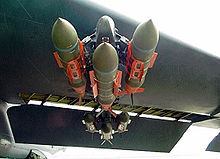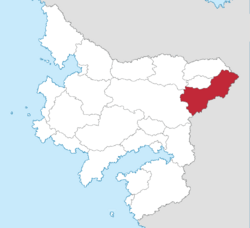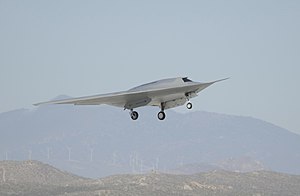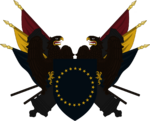User:Greater Carloso/Sandbox 3: Difference between revisions
No edit summary |
No edit summary |
||
| Line 1: | Line 1: | ||
{{Region icon MusgorociaSC}} | {{Region icon MusgorociaSC}} | ||
[[File:JDAM GBU30 MER.jpg|220px|thumb|right|R554 1,000 kg bombs attached to the wing of a [[Carlosian Air Force]] aircraft]] | [[File:JDAM GBU30 MER.jpg|220px|thumb|right|R554 1,000 kg bombs attached to the wing of a [[Carlosian Air Force]] aircraft]] | ||
The '''R550-series''' of {{wpl|general-purpose bomb}}s are a modular family of air-dropped explosives widely utilised by the [[Carlosian Armed Forces]]. They range from the 125 kg R551 to the 4,000 kg R556. In recent years, they have been upgraded with Accuracy | The '''R550-series''' of {{wpl|general-purpose bomb}}s are a modular family of air-dropped explosives widely utilised by the [[Carlosian Armed Forces]]. Designed in the 1980s, they succeeded several types of bombs in service with the Carlosian military, and feature a streamlined design intended to minimise drag. They range in size from the 125 kg R551 to the 4,000 kg R556. In recent years, they have been upgraded with Accuracy and Stand-off Rectification (ASOR) guidance and wing modules which have converted them into precision-guided glide bombs. Initially effective against stationary targets, the addition of laser seekers in combination with ASOR allow them to effectively eliminate moving targets as well. | ||
Starting in 2021, the Carlosian Air Force revealed it had begun testing R551 bombs equipped with a novel ASOR-E kit, which adds a micro-turbojet engine with a maximum thrust of 0.4 kN and an internal fuel tank. This extends the range of the bomb to approximately 175 km (152 nmi, 109 mi), effectively turning ASOR-E equipped bombs into cheap {{wpl|cruise missile}}s to augment Carloso's arsenal of more sophisticated weaponry. Low-rate initial production began in early 2022, with industry sources claiming a combined unit production cost of D£33,580 ($73,000). In 2024 an ASOR-E equipped R553 bomb was debuted, with a touted range of 550 km. Preliminary studies have begun on developing a similar R554 variant, which could match the payload delivered by a [[S774 Rábiar]] air-launched cruise missile. | |||
==See also== | ==See also== | ||
Revision as of 09:24, 20 September 2024

The R550-series of general-purpose bombs are a modular family of air-dropped explosives widely utilised by the Carlosian Armed Forces. Designed in the 1980s, they succeeded several types of bombs in service with the Carlosian military, and feature a streamlined design intended to minimise drag. They range in size from the 125 kg R551 to the 4,000 kg R556. In recent years, they have been upgraded with Accuracy and Stand-off Rectification (ASOR) guidance and wing modules which have converted them into precision-guided glide bombs. Initially effective against stationary targets, the addition of laser seekers in combination with ASOR allow them to effectively eliminate moving targets as well.
Starting in 2021, the Carlosian Air Force revealed it had begun testing R551 bombs equipped with a novel ASOR-E kit, which adds a micro-turbojet engine with a maximum thrust of 0.4 kN and an internal fuel tank. This extends the range of the bomb to approximately 175 km (152 nmi, 109 mi), effectively turning ASOR-E equipped bombs into cheap cruise missiles to augment Carloso's arsenal of more sophisticated weaponry. Low-rate initial production began in early 2022, with industry sources claiming a combined unit production cost of D£33,580 ($73,000). In 2024 an ASOR-E equipped R553 bomb was debuted, with a touted range of 550 km. Preliminary studies have begun on developing a similar R554 variant, which could match the payload delivered by a S774 Rábiar air-launched cruise missile.
See also
TBD
| Greater Carloso/Sandbox 3 | |||
|---|---|---|---|
| |||
| Belligerents | |||
|
Supported by: | |||
| Commanders and leaders | |||
|
| |||
| Units involved | |||
|
Carlosian Armed Forces
| |||
Barssois
Republic of Barssois | |
|---|---|
|
Flag | |
 Location of Barssois (dark green) in Musgorocia (grey) – [Legend] | |
| Capital and largest city | Nouvelle Bar |
| Official languages | French |
| Demonym(s) | Bar |
| Government | Unitary semi-presidential constitutional republic |
| Legislature | National Assembly |
| Population | |
• 2022 census | 125,376,749 |
| HDI (2022) | very high |
| Currency | Bar livre (B₶) (BLV) |
| Date format | dd/mm/yyyy (AD) |
| Driving side | right |
| Internet TLD | .ba |
Barssois, officially the Republic of Barssois is a sovereign unitary semi-presidential constitutional republic located in eastern Musgorocia. Barssois is the largest country in Musgorocia and the second-most populous after Carloso with a population of 125,376,749. Besides its territory in mainland Musgorocia, Barssois also controls Île Solitaire, an isolated island located far to the east in the Libere Ocean.
Days of May
| Days of May | |||||||
|---|---|---|---|---|---|---|---|
 Imperial Army forces on the streets of Madrigal. | |||||||
| |||||||
| Belligerents | |||||||
|
|
| ||||||
| Commanders and leaders | |||||||
|
|
| ||||||
| Strength | |||||||
| 350,000 soldiers | 150,000 soldiers | ||||||
| Casualties and losses | |||||||
| 97 killed | 185 killed | ||||||
| 102 civilians killed | |||||||
The Days of May, sometimes referred to as the Carlosian Proto-Civil War, was a brief conflict fought from 21 May to 29 May 1932 between forces loyal to the Emperor of Carloso, Sébastien II, and forces aligned to the republican President of the Imperial Council Jerónimo Fonseca. The crisis began when Sébastien's forces ordered the arrest of Fonseca in response to his plan to hold a referendum on the abolishing of the monarchy later in the year. Narrowly escaping, Fonseca rallied his supporters in Valderosa, while large portions of the Imperial Armed Forces defected. Within hours, clashes had broken out across Carloso, while Sébastien dissolved the Imperial Assembly and implemented absolute rule. Major cities across Carloso quickly saw major fighting break out between the factions, while criminal elements took advantage of the situation, looting and raiding banks. Ultimately, Sébastien dashed expectations when he abdicated on 29 May 1932, wishing to avoid the conflict escalating and destroying the country.
Carloso was immediately faced with a constitutional crisis following Sébastien's abdication, as the Carlosian Empire was not formally dissolved and Felipe, Prince Imperial should have legally succeeded him as Emperor. Felipe, however, did not pursue this claim, and most constitutional issues were resolved over the following number of days when Fonseca returned to Madrigal and hurriedly passed through several constitutional amendments which erased nearly all mentions of the Empire and the Imperial Family from the country's constitution, signed into law by Sébastien's Counsellors of State, including the legislation which dissolved that particular body. Many of the powers once held by the Emperor were then transferred to the Executive Council, in particular the position of President of the Executive Council, transforming the office into its current role as both head of government and ex officio head of state.
Most historians view Sébastien II's decision to abdicate favourably, praising him for ending the crisis and avoiding the potential devastation of Carloso by a lengthy civil war.
Sinistral War
| Sinistral War | |||||||
|---|---|---|---|---|---|---|---|
| |||||||
| Belligerents | |||||||
Gran Laurencia |
| ||||||
| Commanders and leaders | |||||||
|
|
| ||||||
| Strength | |||||||
|
24,000 soldiers 19,000 natives 100 rōnin |
15,000 soldiers 6,000 loyalists | ||||||
| Casualties and losses | |||||||
| 10,000 dead | 11,000 dead | ||||||
| 10,000 civilians dead | |||||||
The Sinistral War
Alongside the forces of Cárlos de Oso was extensive support from Musgorocian Aboriginals, as well as unexpected support from a band of wandering Nifonese rōnin lead by Tadashi Katsuragi.
At the height of the Battle of Madrigal, Savastian Bergara was ultimately slain in a duel with Nifonese rōnin Tadashi Katsuragi, and shortly aftwards all Spanish forces in the city surrendered, de facto ending the war. After the recognition of independence in 1581, the Directorate of Carloso was formed, taking its name from that of Cárlos de Oso, in recognition of his leadership as commander of the military forces of the United Colonies and his sacrifice at the Battle of Madrigal.
Almendara Strategic Complex
| Almendara Strategic Complex | |
|---|---|
| Tonderteira, Lagosa, Carloso | |
| Type | Nuclear bunker |
| Site information | |
| Controlled by | |
| Site history | |
| In use | 1993–present |
The Almendara Strategic Complex is a military installation located in the Almendara Mountains. Highly classified, it is believed to have been originally built as a nuclear bunker following the Bourgougian Blitz, though since 2012 satellite imagery has indicated it has been massively expanded with both overground and underground facilities added, as well as extensive perimeter defences. The area in Tonderteira, Lagosa where the facility is located is closed to civilian access.
Operation Aúger
| Operation Aúger | |||||||
|---|---|---|---|---|---|---|---|
 Carlosian cruise missiles fly towards targets in Bourgougia during the bombardment | |||||||
| |||||||
| Belligerents | |||||||
|
|
| ||||||
| Commanders and leaders | |||||||
|
|
| ||||||
| Casualties and losses | |||||||
| None |
5,841 dead 18,199 injured | ||||||
Operation Aúger was a military operation launched by the Carlosian Armed Forces against Bourgougia between 10–11 August 2011. Launched in retaliation in response to the 5 August shootdown by Bourgougian forces of a Carlosian Air Force passenger plane carrying medical personnel and a military attaché to Cispania, it was ordered by recently elected President Cárlos Tobón. Carlosian forces stationed mainly in southern Carloso and Agostinia launched a colossal barrage of 946 cruise and ballistic missiles, destroying barracks, airfields and surface-to-air batteries of the Bourgougian Armed Forces. The attack was launched from both ground-based batteries of the Carlosian Army and aircraft of the Carlosian Air Force.
Despite fears that the retaliation risked causing a repeat of the Bourgougian Blitz, it quickly became apparent that the Bourgougian Armed Forces only wielded a fraction of its historical capability. President Étienne Dubois was forced to back down, acquiescing to Carlosian military supremacy and handing Tobón his first foreign policy and military victory.
Universal War
Supreme Court
The Supreme Court of Carloso is the highest court in the judiciary of Carloso. It was established in 1933 to take over the functions of the Council of State as the supreme judicial authority in Carloso, having inherited that function from the Privy Council under the Carlosian Empire.
Justices are appointed by the President of Carloso, as stipulated by the Constitution. The President does not need to seek the approval of the National Assembly on appointments and may, in theory, make any Carlosian citizen a justice, though by convention all past justices have been barristers or even solicitors with years of legal experience. Justices may by removed from office by a two thirds majority vote of the National Assembly.
| Name | Appointed | Alma mater | Prior roles | Notes |
|---|---|---|---|---|
| Muruaga Hinestrósa | 24 January 2001 | University of Tadrid (LLB) University of Madrigal (LLM) TBD Inn (BL) |
Chief Justice | |
| 2002 | ||||
| 2004 | ||||
| 2009 | ||||
| 2011 | ||||
| 2011 | ||||
| 2014 | ||||
| 2018 | ||||
| 2022 |
Gagon
Gagon | |
|---|---|
|
Flag of Gagon Flag | |
 Map of Carloso with Gagon highlighted | |
| Country | |
| Capital | Reras |
| Circuits | Canone, Guaseu, Hona, Meabaca, Memis, Modiria, Pobal, Reras, Sense, Virro |
| Government | |
| • Type | Provincial government under a constitutional republic |
| • Body | Provincial Council |
| • Chief Minister | Aitor Estrada (NS) |
| • Deputy Minister | Eron Laurier (NS) |
| • Legislature | Provincial Assembly |
| Population (2022) | |
| • Total | 1,891,723 |
| Demonym | Gagonian |
| Postcode area | GA |
| Official languages | |
| NAs | 6 (out of 859) |
| Website | gagon |
Gagon, officially the Province of Gagon is a province of Carloso. Located in the north-east of the country, it is composed of ten circuits, Canone, Guaseu, Hona, Meabaca, Memis, Modiria, Pobal, Reras, Sense, Virro. It borders Cartalusia to the west, Rioron to the north-west, Ebon and Castirin to the north and has an international border with Sarabagia and Orticuria to the east. With a population of 1,891,723 according to the 2022 census, it is the second least populous province of Carloso overall and the least densely populated. Gagon has a varied climate, with the western part of the province having vast, fertile pastures and forests. The centre of the province has drier grasslands while the most easterly parts of the province are semi-desert badlands as result of the rainshadow cast by the TBD Mountains. Most of the population is concentrated in Virro and Modiria, which are the major agricultural regions, as well as Pobal and Reras, due to the urban sprawl of the neighbouring city of Ebon. Major economic activities include tillage and cattle ranching, as well as mining and tourism.
The provincial capital is Reras, itself a satellite city of Ebon. The first Carlosian nuclear weapons test took place in Gagon's badlands in 1951.
History
Gagon was created, alongside Castirin, on 17 September 1883 when the Provincial Government Act 1882 came into effect, partitioning the then much larger province of Ebon. The decision to create two new provinces was a result of the rapid growth of Ebon city, which many had felt left more rural areas deprived of representation in the Ebon Provincial Council. A plebiscite was held in the ten circuits which presently constitute Gagon, passing overwhelmingly, a similar vote being held in Castirin. The decision was made to name the new province after Agustín Gagon, a prominent rancher and politician known for his lifetime work in advocating for the interests of the region, who had died in 1879.
Geography
Administration
With two National Assembly constituencies, totalling six National Assemblymen (NAs), Gagon has the second smallest number of representatives in the national legislature, just ahead of the Cadena Islands. The Gagon-1 constituency encompases Reras, Memis, Canone, Sense, Guaseu and Meabaca circuits, while Gagon-2 contains Pobal, Virro, Modiria and Hona. The 123-member Provincial Assembly is Gagon's legislative body. National Salvation (NS) secured a majority in the 2017 provincial elections, and have maintained it in subsequent elections. The executive Provincial Council is formed from members of the Assembly. It is headed by a Chief Minister, currently Aitor Estrada, and a Deputy Minister, currently Eron Laurier. The Provincial Assembly sits in Reras, as does the province's High Court and Court of Appeal. As with Carloso's other provinces, each of Gagon's circuits is governed by a circuit council.
Economy
Gagon's economy is dominated by agriculture, specifically cattle ranching and tillage, as well as their associated industries. Most agricultural products are ultimately destined for the markets in neighbouring Ebon and other provinces of Carloso, with exports to Orticuria and Sarabagia also being significant. Mineral extraction is also a major sector of the province's economy, including lithium, zinc and ilmenite, the latter of which is used in the production of titanium and titanium oxide.
Demographics
Acrary War of Independence
| Acrary War of Independence | |||||||||
|---|---|---|---|---|---|---|---|---|---|
 Carlosian forces in Acrary, 1921 | |||||||||
| |||||||||
| Belligerents | |||||||||
|
| |||||||||
| Commanders and leaders | |||||||||
|
|
| ||||||||
| Units involved | |||||||||
|
Carlosian Armed Forces
Imperial Police
Castirin Police Ebon Police Gagon Police | |||||||||
| Strength | |||||||||
| 15,000 fighters |
20,000 soldiers 11,000 police | ||||||||
The Acrary War of Independence (30 April 1919 – 18 July 1921) was a guerrilla war fought between the Acrary Republican Army (ARA) and Carlosian Armed Forces in the north-eastern land-locked province of Acrary. Acrary had been under Carlosian rule since 1831, having been a British colony that was annexed by the newly established Carlosian Empire in the Glorious War. With a population that was overwhelmingly of British and Irish ancestry and next to no linguistic knowledge of the Carlosian language, the vast majority of Acrarians did not identify themselves as Carlosians throughout the period of the Empire's rule. However, attempts to agitate for independence were nonetheless limited until the 1910s, when the nationalist ARA began a campaign of bombing attacks on Carlosian targets throughout Acrary and the north-western provinces of Ebon, Castirin and Gagon. As the unity of the Empire began to fray under the rule of Sébastien II, the Red Vanguard uprising in 1919 spurred the ARA to escalate the conflict into a full-blown guerrilla war against Carlosian forces. Reprisals by law enforcement and the Imperial Army increased support for the ARA and its efforts. Throughout 1920 and early 1921, fighting escalated, but Carlosian forces appeared to gain the upper hand, capturing hundreds of fighters in several military operations.
Despite their success, the realisation gradually came about in Carloso that Acrary had been rendered ungovernable and the cost of building and reintegrating it into the Empire would be prohibitive. Ultimately a truce was called on 18 July 1921. By this time, up to 2,000 civilians had been killed, while approximately 700 ARA members were dead and 1,000 Carlosian soldiers and police. Running low on ammunition and with hundreds of their fighters imprisoned, the ARA agreed to disarm. In return, the Carlosians granted Acrary a form of quasi-independence, allowing it to secede from the Empire but maintaining control over the country's foreign and security policy. Several thousand Carlosian soldiers would then be stationed in Acrary. The Acrary Republican Army was reformed into the Acrary Armed Forces.
The loss of Acrary precipitated the 1922 coup attempt by Marchioness Estefania Luciana, which further weakened Sébastien II's reign. With the collapse of the Carlosian Empire on 29 May 1932, Carlosian forces were ordered to withdraw from Acrary, definitively ending Carlosian rule and making Acrary a de facto independent state. Carloso officially recognised Acrary's independence in 1941 and both countries signed a treaty of friendship, allowing the isolated Acrarian state to access international markets through Carloso.
Verdástrun U911 Rátpenat
| U911 Rátpenat | |
|---|---|

| |
| Role | Unmanned combat aerial vehicle |
| National origin | |
| Manufacturer | Verdástrun |
| First flight | 2017 |
| Introduction | 2019 |
| Status | In service |
| Primary user | Carlosian Air Force |
| Produced | 2017–present |
| Number built | >30 |
The Verdástrun U911 Rátpenat stealth unmanned combat air vehicle (UCAV) manufactured by Verdástrun for the Carlosian Air Force.
Novaria
Novarian Corporation | |
|---|---|
|
Flag | |
| Capital and largest city | Port Vevina |
| Official languages | English |
| Demonym(s) | Novarian |
| Government | Unitary corporate republic under a board of directors |
| Population | |
• 2022 census | 94,782 |
| HDI (2022) | very high |
| Currency | Novarian dollar (N$) (NOV) |
| Date format | dd/mm/yyyy (AD) |
| Driving side | left |
| Internet TLD | .no |
Novaria, officially the Novarian Corporation is a corporate republic encompassing most of the subcontinent of Novaria in Musgorocia. Human habitation in Novaria was historically sporadic and always temporary, and ceased entirely with the decline of the whaling industry worldwide in the 20th century. After the discovery of vast petroleum and natural gas reserves in 2005, a consortium of Musgorocian companies established the Novarian Corporation to extract the resources and develop the landmass. As the infrastructure to support the company's activities rapidly expanded, it became increasingly clear that a proto-state was emerging. The capital of Port Vevina was established in 2011, and with it an airport and seaport. High-rise apartments were constructed to house foreign workers, while the Novarian Corporaton began to diversify its activities, attracting scientific and financial enterprises with its low-taxation regime and near lack of regulations. It also began to be marketed as a tourist destination, specifically for luxury holidays to Port Vevina, safaris into the vast taiga and tundra, as well as events such as the Axíoma Zero racing championship. In 2018, Carloso established a Consulate in Port Vevina, de facto recognising Novaria as an independent state, with other Musgorocian countries following afterwards. The population of Novaria is expected to rise significantly in the coming years, projected to hit 150,000 by 2030.





